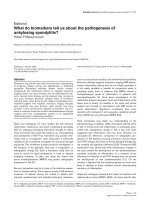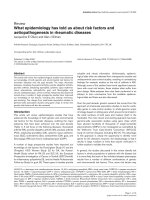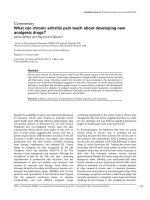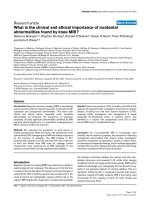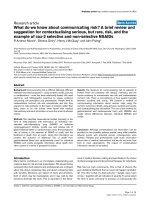Báo cáo y học: " What my genome told me - and what it didn’t" pptx
Bạn đang xem bản rút gọn của tài liệu. Xem và tải ngay bản đầy đủ của tài liệu tại đây (43.62 KB, 3 trang )
Genome
BBiioollooggyy
2009,
1100::
108
Comment
WWhhaatt mmyy ggeennoommee ttoolldd mmee aanndd wwhhaatt iitt ddiiddnn’’tt
Gregory A Petsko
Address: Rosenstiel Basic Medical Sciences Research Center, Brandeis University, Waltham, MA 02454-9110, USA.
Email:
Published: 29 June 2009
Genome
BBiioollooggyy
2009,
1100::
108 (doi:10.1186/gb-2009-10-6-108)
The electronic version of this article is the complete one and can be
found online at />© 2009 BioMed Central Ltd
Well, it turns out I’m not descended from Genghis Khan. I’m
sure that’s as surprising to you as it is to me. I mean,
according to what we hear from people who use genomics to
track human migrations, a huge percentage of the human
race is actually descended from Genghis Khan. But not me.
That’s one of the things I learned when I submitted a sample
of my DNA for genome-wide single nucleotide polymor-
phism (SNP) analysis by one of the companies that have
sprung up to perform such tests for ordinary individuals for
a fee. I was curious to see what sort of information they
provide, and wanted to know something about my own
genomic makeup, to be honest, so I followed the directions
of the company I had selected and spat into a plastic
container until I produced the required volume of saliva,
mailed it in, and awaited the results. Would I have an allele
that doomed me to a rare genetic disorder as I got older?
Was I at much higher than normal risk for heart disease,
diabetes, or any of the other thousand natural shocks that
flesh is heir to? Was I descended from Genghis Khan?
The company I sent my saliva sample to doesn’t actually do
any DNA sequencing or hybridization itself; it contracts this
out to a specialist laboratory. Once the lab received my
sample, DNA was extracted from cheek cells in the saliva
and amplified by PCR to produce enough material for the
genotyping step. Next, the DNA was cut by restriction
digestion into smaller, more manageable pieces. These DNA
pieces were then applied to a DNA chip, which in this
specific case is a small glass slide with millions of
microscopic beads on its surface. Attached to each bead are
the probes - bits of DNA complementary to those specific
sites in the human genome where important SNPs are
located. There is a pair of probes for each SNP, corres-
ponding to the ‘normal’ and ‘non-normal’ version of each
SNP. Hybridization to the particular probe, detected by
fluorescence just as in the case of any other DNA chip
experiment, serves to identify the allele.
The DNA chip that this particular company uses reads
550,000 SNPs that are spread across the entire genome.
Although this is still only a fraction of the 10 million SNPs
that are estimated to be in the human genome, these
550,000 SNPs are specially selected ‘tag SNPs’ - because
many SNPs are linked to one another, the genotype at many
SNPs can often be determined by looking at one SNP that
‘tags’ its group. This tagging procedure maximizes the
information from every SNP analyzed, while keeping the
cost of analysis low.
In addition, all the DNA analysis companies have hand-
picked tens of thousands of additional SNPs of particular
interest from the scientific literature and added their
corresponding probes to the DNA chip. These SNPs include
risk factors for common and rare human diseases, genetic
traits such as color blindness, and so on.
Access to the resulting data is through the company’s
website, which includes the ability to download the entire set
of SNP information. Once I was notified that my results were
in, I did that, and being a scientist I performed my own
bioinformatics on the data, but the website actually does a
pretty good job of providing the customer with specific
information about alleles for various illnesses, physical
traits, and so on.
Here are a few of the things I leaned about myself, physically
speaking:
According to my genome, my eye color is likely to be brown
(good guess). I should be lactose tolerant (I am). My
cytochrome P450 data show that I would be quite sensitive
to the anti-clotting drug warfarin if I ever had to take it
(which I hope I never do - it’s a nasty drug). The SNPs in my
androgen receptor gene say that I am considerably
decreased in risk for male pattern baldness (I have news for
them; I’m getting rather thin on top). I have a SNP in a
dopamine receptor gene that, in one German study, was
found to be associated with reduced efficiency in learning to
avoid errors (unless I got the facts wrong). According to a
single SNP in one gene associated with insulin metabolism, I
have increased odds of living to be 100 (that is, if all the
mistakes I don’t learn to avoid don’t get me first). There are
a number of SNPs that have, in some studies, been asso-
ciated with increased athletic performance (faster running,
quicker reaction times, and so on). I don’t have any of them,
which will come as no surprise to any of my gym teachers.
I am at slightly increased risk, relative to the norm, for rheu-
matoid arthritis and psoriasis (that last one is interesting,
because my father suffered from it). I am at slightly
decreased risk for Celiac disease, Crohn’s disease, type 1
diabetes, and prostate cancer. In all cases, the change is
small - less than two-fold difference, and not enough to
cause me to consider any lifestyle changes.
But one thing did jump out at me when I looked at my
data. I have a guanine at rs1799945, which is located in the
gene coding for a protein called HFE. HFE is the protein
mutated in hereditary hemochromatosis. Hereditary
hemochromatosis, the most common form of iron overload
disease, is an autosomal recessive genetic disorder that
causes the body to absorb and store too much iron. Excess
iron is stored throughout the body in organs and tissues,
including the pancreas, liver, and skin. Without treatment,
the iron deposits can damage these organs and tissues. There
are two primary variants that give rise to this disease.
Genetic variant 1 (C282Y/rs1800562) is in the HFE gene. The
HFE gene makes a membrane protein that is similar
structurally to MHC class I-type proteins and associates with
β2-microglobulin. It is thought that HFE helps cells in the
intestines, liver, and immune system control iron absorption
by regulating the interaction of the transferrin receptor with
transferrin. The C282Y substitution disrupts the interaction
between HFE and its β2-microglobulin light chain and
prevents cell-surface expression. Pamela Bjorkman’s 2.6 Å
resolution crystal structure of HFE confirms that, as predicted
from its sequence, Cys282 (residue 260 in the mature form of
the protein) is involved in a disulfide bridge analogous to
those found in class I MHC α3 domains. Loss of the disulfide
destabilizes the native fold of the protein. The second most
common variant is also in the HFE gene. It is a change of
histidine 63 to aspartic acid. In the crystal structure of HFE,
His63 (41 in the sequence of the mature form) is involved in a
crucial salt bridge, which would be destroyed by mutation to a
negatively charged residue, thereby also destabilizing the
protein. Thus, like so many other hereditary disorders,
hemochromatosis is a protein conformational disease.
In the US, variant 1 is the more frequent. The ‘normal’
Cys282 allele has guanine in both strands and is found in
about 876 out of 1,000 people of European ancestry. The
most common form of hereditary hemochromatosis is
typically associated with people homozygous for an adenine
in both positions; this occurs in about 4 out of 1,000 people
of European ancestry (0.4%). However, penetrance is
incomplete: only about a third to a half of the homozygotes
will show elevated iron levels and perhaps fewer than 10% of
the males (and 1 to 2% of the females) will develop the full
clinical symptoms of the disease, which include joint pain,
fatigue, abdominal pain, liver dysfunction, and heart prob-
lems. As Ernest Beutler has pointed out, the hemochroma-
tosis mutation is relatively common; the hemochromatosis
disease is rare. Mutation of the HFE gene is a necessary, but
not sufficient, condition. The challenge, as in the case of so
many diseases in the age of genomics, is to understand what
other genetic, epigenetic, and environmental factors deter-
mine why a few homozygotes for the C282Y (or H63D) muta-
tions develop severe iron-storage disease, while the majority
go through life pretty much unscathed by this genotype.
Heterozygotes for C282Y have an adenine in only one strand
and represent about 120 in 1,000 people of European
ancestry; they almost never develop clinical symptoms.
Heterozygotes for H63D are less common, but also are
unlikely to develop clinical symptoms. Like one person in
ten in the United States, I am a hemochromatosis carrier. I
am heterozygous for H63D.
Now that I know that, what does it do for me? Not much, I
guess, but I will remember it, and should I ever develop any of
the symptoms of iron overload, I will probably tell my
physician to check my iron levels. Maybe that’s worth knowing.
But if you go to the website of the company that did my
analysis, you will find that the sort of information I’ve talked
about here is actually not that prominently displayed. What is
displayed are all manner of data connecting to ancestry. I
spoke to the CEO of the company, and she confirmed that,
much to their surprise, people who use their service are much
more interested in tracing their roots, genetically speaking,
than they are in things related to their health or physical
condition. The site offers several tools for connecting yourself
with others who share your ancestry, genetically speaking. In
other words, for the present, the primary use of personal
genome-wide SNP analysis is social networking.
My maternal haplogroup is T2b2. Haplogroup T originated
about 33,000 years ago in the Middle East, as modern
humans first expanded out of eastern Africa. Its present-day
geographic distribution is strongly influenced by multiple
migrations out of the Middle East into Europe, India, and
eastern Africa after about 15,000 years ago. T2 is currently
widespread in northern Africa and Europe. My mother’s
family most recently came from Italy, so I guess this makes
sense. You can find famous people with your haplotype on
the site: for example, if your maternal haplotype is H4a, you
have the same type as Warren Buffet, one of the richest men
/>Genome
BBiioollooggyy
2009, Volume 10, Issue 6, Article 108 Petsko 108.2
Genome
BBiioollooggyy
2009,
1100::
108
in the world. You’ll be delighted - and perhaps not surprised -
to know that the only famous person the site lists as sharing
my maternal haplotype is the notorious old-west outlaw
Jesse James.
My paternal haplotype is I2. Haplogroup I2 is most abun-
dant in eastern Europe and on the Mediterranean island of
Sardinia, where it is found in 40% of the male population.
Like its brother haplogroup, I1, I2 expanded northward at
the end of the Ice Age about 12,000 to 14,000 years ago. But
unlike I1, which expanded from the Iberian peninsula into
northwestern Europe, I2 radiated outward from the Balkans
and southwestern Russia into the eastern half of the
continent. That again makes sense, as my father’s family
were Cossacks. If my paternal haplotype were the extremely
common C3, I would be descended from Genghis Khan. I’m
not. If it were type T, I would share paternal lineage with the
great American president and founding father Thomas
Jefferson. I don’t. In fact, the company website doesn’t list a
single famous person with paternal haplotype I2 (unless you
count me, of course).
So now, thanks to my own personal genome SNP analysis, I
know that I’m not likely to be exceptionally athletic and that
I’m not a blue-eyed balding blonde, neither of which comes
as any surprise whatsoever. But I have also learned that I’m
not descended from Genghis Khan. So I’ve got that going for
me. Which is something, I suppose.
/>Genome
BBiioollooggyy
2009, Volume 10, Issue 6, Article 108 Petsko 108.3
Genome
BBiioollooggyy
2009,
1100::
108


